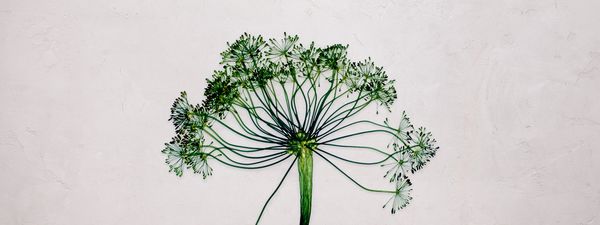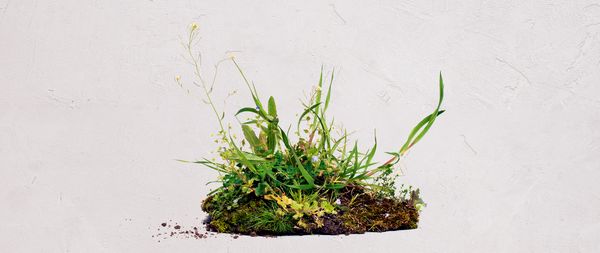Between grass and moss, one can always find delicious wild herbs. Better bend down than step on it.

Plants that used to be considered weds are now giving classic herbs like basil and parsley a run for their money in top-flight kitchens. So why not head out foraging?
WILD HERBS
THOUSANDS OF YEARS BACK, the founder of herbal medicine, Hippocrates, knew how beneficial wild plants could be – and millennia later, all you need to do is to go out foraging to find out how useful they are in the kitchen, too. Looked out through a culinary lens, even our arch-enemies can become allies: stinging nettles and ground elder, for instance, make great pesto or dips – and taste good sweated down with garlic or onions; tender leaves of dandelion, sorrel, or lady’s mantle can add zest to a salad or a smoothie. Due to high concentrations of essential oils, other wild herbs need to be used somewhat more sparingly to avoid strong tastes becoming strong effects: herbs don’t have medicinal uses for nothing, after all. What is more, many wild herbs have poisonous lookalikes, so the first rule of foraging is always: only pick things you can reliably identify. Anyone just startingout should start by reading and following a good guide. Another important element is where you forage: avoid areas next to busy roads or fields which farmers treat with pesticides. One way to make absolutely sure the herbs are safe, of course, is to grow your favourites at home on the balcony, on the windowsill, or in the garden: now that star chefs have taken to using wild herbs, retailers have reacted by stocking seed collections.
WILD HERBS ARE RICH IN ESSENTIAL OILS AND PACK A FLAVOUR PUNCH. YOUNG PLANTS TEND TO TASTE FRESHER AND MILDER. AS THEY GET OLDER, THEY TAKE ON A SOURER, TARTER FLAVOUR.

HOT
Coltsfoot – Tussilago farfara – is native to Europe, Africa, Asia and North America. It likes clay soils and produces leaves which are ideal for use as vegetables: coltsfoot can replace spinach in a variety of dishes, including in oven bakes; it can even be used in sushi. Since antiquity, this nutritious herb has been used against respiratory illnesses.
TART
Found worldwide, ribwort – Plantago lanceolata, also known as narrowleaf plantain or lamb’s tongue – grows along roads and woodland paths from April to November. It has a tart note reminiscent of porcini mushrooms that works well in herb dips, salads and pasta dishes and harmonises with eggs. As a herbal tea, it is a proven cough remedy and can, just like coltsfoot, be smoked –e.g. as a tobacco substitute when giving up.
CLOVER, GROUND IVORY AND DANDELION
COOL
Comphrey is the common name for the Symphytum genus whose leaves can add flavour to salads, juices, doughs, and omelettes; lightly sautéed, the root can be eaten too. Despite the fact it only counts 40 species, Symphytum can be found everywhere from Europe to Central Asia, growing in damp places such as riverbanks, meadows, ditches, and lowland woods. Older names include knitbone and boneset, referring to its historical uses in traditional medicine.
SHARP
The A-lister among wild herbs, most people know that you can eat dandelion leaves, sweated like spinach or, if young, tender, and still mild, in salads. Native to Western Asia and Europe, Taraxacum, to give it its proper name, is now found more or less everywhere in the northern hemisphere.
TANGY
The tender leaves of the yarrow plant are a great addition to salads, soups and dips and can also be used to infuse vinegar. Widespread in Europe between the Arctic Circle and the Alps, it can also be found in subtropical areas in Eurasia, North Africa and America. Its medicinal effect is the stuff of legend: Achilles is said to have used it to heal his wounds (its binomial name is Achillea).

MAGNIFICIENT: GOUTWEED
When goutweed is blossoming already, you're too late. The mild taste of young leaves i what you're looking for. Steamed breifly in olive oil, they complement pasta and potato dishes perfectly.
"Respect means understanding what nature provides"
SOUR
The sharp taste of wood sorrel makes it an excellent way to freshen up soups, salads, and even desserts. It is delicious sautéed, too, but shouldn’t be eaten in excesse quantities: just like spinach and chard, it contains large amounts of oxalic acid. Over 800 species of its eponymous genus Oxalis can be found across the world in shady, damp locations.
A TRUE ALL-ROUNDER
Cresses thrive in damp, nutrientrich soils across the Northern hemisphere and have impressive quotients of vitamin C, iron, potassium, calcium, silicon, and chlorophyll. The only drawback is picking them. Against all expectations, however, the leaves don’t burn on the tongue – neither sautéed nor raw. Quite to the contrary, actually, and cress leaves are fantastic in pesto, as a stuffing for fish or meat, and in soups. Look out for the younger, tender leaves at the top of the plant.
THE FIRST RULE OF FORAGING IS ALWAYS TO ONLY PICK THINGS YOU CAN RELIABLY IDENTIFY, BECAUSE MANY WILD HERBS HAVE POISONOUS LOOKALIKES.

BEAUTY ELIXIR: STINGING NETTLES
The tender, yet aromatic sprouts have a detoxifying effect and tighten the connective issue due to their high vitamin C content. Perfect for a detox smoothie.


